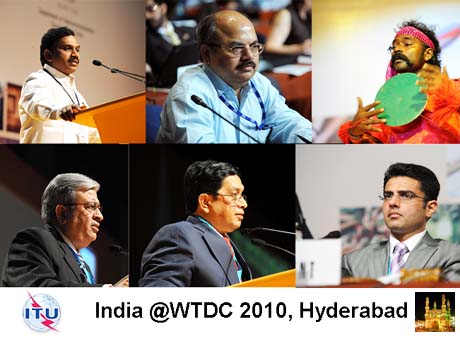
The ITU World Telecommunication Development Conference has adopted the Hyderabad Action Plan at the end of 10 days of deliberation, outlining a road map to foster the global development of information and communication technology (ICT) networks and services over the next four year cycle.
The roll out of next-generation networks (NGN) and increased access to broadband services, wireless technologies and the Internet were seen to be the catalysts to achieve broad development goals.
The Hyderabad Declaration states: “Broad access to telecommunications and ICTs is essential for the world’s collective economic, social and cultural development, and the building of a global Information Society. This access brings new opportunities for interaction amongst people, for sharing of the world’s knowledge resources and expertise, for transforming people’s lives, and for contributing to the global development agenda.”
The fifth World Telecommunication Development Conference (WTDC-10), which met from 24 May until 4 June in Hyderabad, India, attracted 924 participants, including 758 government delegates from 138 countries and 6 representatives from Palestine; 88 public and private sector representatives from 28 companies; 16 representing telecommunication-related entities from 7 countries; and 56 representatives from 25 regional and international organizations. In addition, 240 media covered WTDC-10 onsite. P.J. Thomas, Secretary, Department of Telecommunications of the Government of India, was elected Chairman of the Conference.
The Hyderabad Action Plan consists of a comprehensive package that will promote the equitable and sustainable development of telecommunication and ICT networks and services worldwide. The five Programmes identified are:
1. Information and communication infrastructure and technology development
2. Cybersecurity, ICT applications and IP-based network-related issues
3. Enabling environment
4. Capacity-building and digital inclusion
5. Least developed countries, countries in special need, emergency telecommunications and adaptation to climate change
“Mobile telephony has grown phenomenally, and as we approach the 5 billion mark for mobile subscriptions later this year, it is considered to be the most rapidly adopted technology in history,” ITU Secretary-General Hamadoun Touré said as he addressed the closing session of WTDC-10. “Yet, the digital divide remains — particularly where accessibility to broadband services and the Internet is concerned. This broadband divide must be addressed by governments and industry as a priority if we are to fully utilize the capacity of ICTs to meet the Millennium Development Goals.”
The delivery of equitable and affordable broadband access to the Internet is a key ITU initiative aimed at achieving a knowledge-based information society and to help achieve the Millennium Development Goals (MDGs).
The WTDC-10 Hyderabad Action Plan is the culmination of a series of regional preparatory meetings that took place in Kuala Lumpur, Malaysia (for Asia-Pacific); Kampala, Uganda (Africa); Santa Marta, Colombia (Americas); Minsk, Belarus (CIS); Andorra La Vella (Europe); and Damascus, Syria (Arab States).
WTDC-10 Hyderabad hosted a series of events to bring attention to the catalytic role that ICTs play in achieving broader development goals.
• A session on ‘e-Health’ aimed at enhancing countries’ capacity to develop or update national e-Health strategic plans.
• The transition from analogue to digital broadcasting was addressed as were trends in policy and regulatory reform.
• ITU’s World Telecommunication/ICT Development Report 2010 (www.itu.int/publ/D-IND-WTDR-2010/en ) was launched on 25 May, providing a mid-term review of the progress made in creating a global information society by 2015.
• ICT Ministers and senior officials from several countries around the world participated in a round table session dedicated to ITU’s flagship initiative, ‘Connect a School, Connect a Community’ (www.conneactaschool.org ) aimed at providing broadband access to schools.
• A session on the ‘ITU Academy’ (http://academy.itu.int ) demonstrated a new portal that makes available ICT learning and development opportunities at the highest possible levels of quality.
Following the ministerial round table on Connect a School, Connect a Community and the session on ITU Academy, several commitments of support were forthcoming. Among them,
Rajiv Mehrotra, Chairman and CEO of VNL India announced that VNL’s “World GSM” solar powered rural telecommunication infrastructure will be extended to village schools and communities in South Asia. This contribution is aimed at enabling mobile telephony and wireless broadband connectivity for Internet access in remote and inaccessible regions of the country where power supply is erratic or not available. June 5 2010